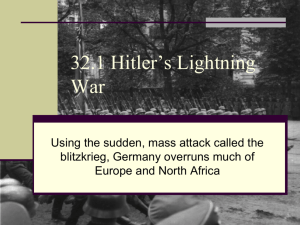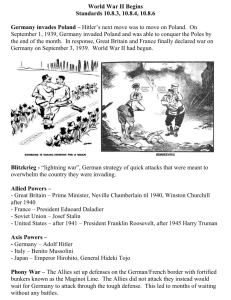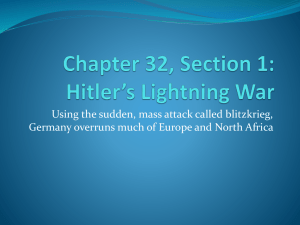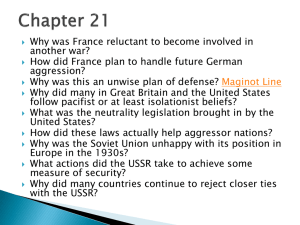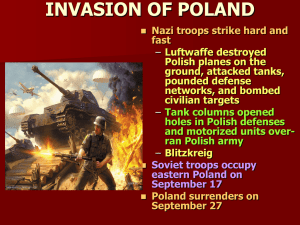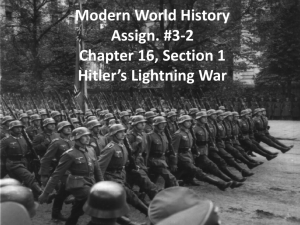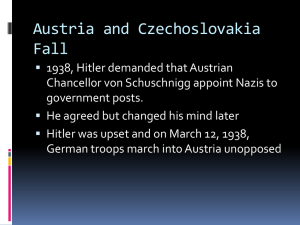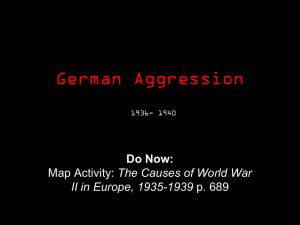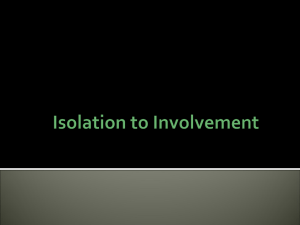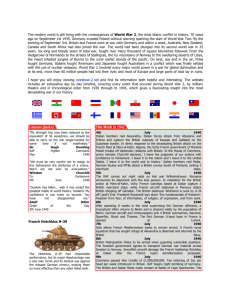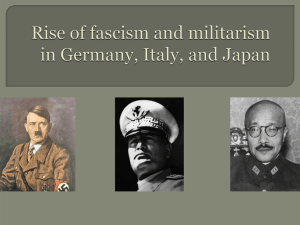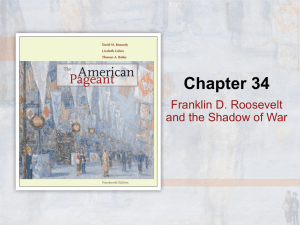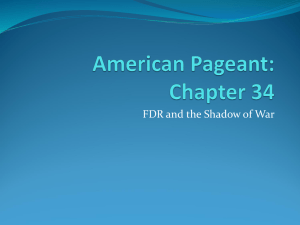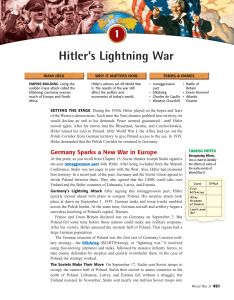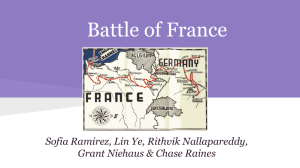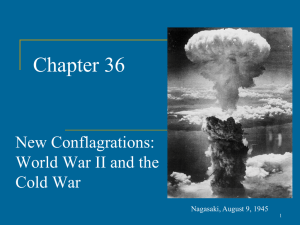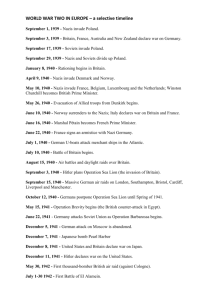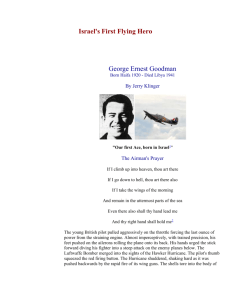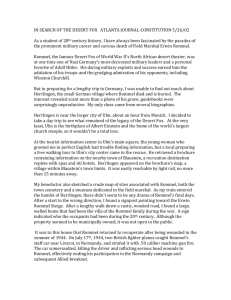Hitlers Lightning War
advertisement
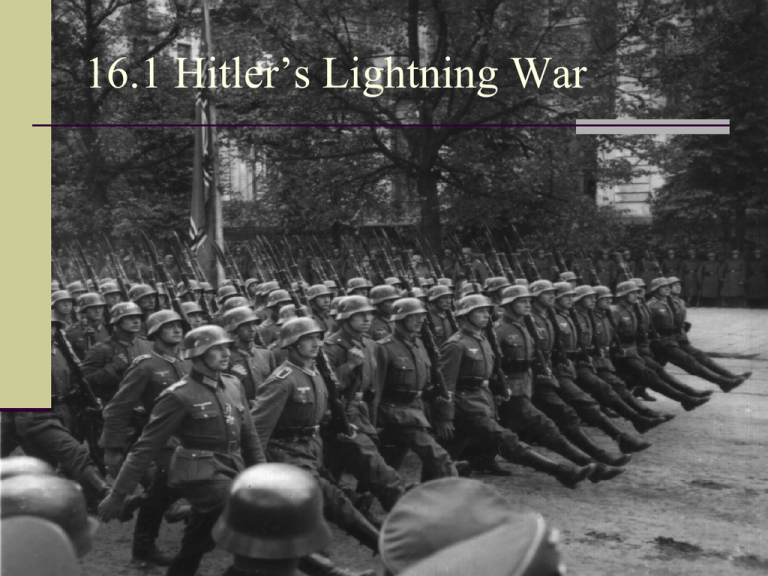
16.1 Hitler’s Lightning War Grab a paper answer questions on the back Bell-Ringer Review! 1) What did the Treaty of Versailles outline to Germany? 2) What was it called when the allies agreed to give Hitler what he wanted? 3) Who are the axis powers? Germany Sparks a New War in Europe Secret Agreement Nonaggression pact—Germans and Soviets agree not to fight each other. This was known as the “Molotov-Ribbentrop Pact” signed in 1939. Hitler: No threat from the east Stalin: Takeover of Baltics and no threat from Germany Ribbentrop and Stalin at the signing of the Pact USSR Germany Text of the secret protocol (in German) Germany Sparks a New War in Europe Germany’s Lightning Attack September 1, 1939—Hitler launches invasion of Poland Britain, France declare war on Germany, but Poland falls quickly Blitzkrieg—lightning war—Germany’s new military strategy Planes, tanks, infantry used to surprise enemy and quickly conquer Germany’s Lightning Attack The Soviets Make Their Move Soviets capture Lithuania, Latvia, Poland, resistance met in Finland Finland is invaded by the Soviet Union in what is called the “Winter War.” Finland surrenders in March, 1940 The Finns name the incendiary device the “Molotov Cocktail” after Soviet foreign minister Molotov during the Winter War. Germany’s Lightning Attack The Phony War French, British mobilize along French border, wait for German attack Many months of no action—the “phony war” In April 1940 Hitler attacks and quickly captures Denmark and Norway British Ministry of Home Security poster of a type that was common during the Phony War •Denmark quickly surrenders to the Nazis and cooperates with the German occupation. •King Christian X becomes a symbol of Danish resistance when he stays in his capital of Copenhagen and still goes on a daily horseback ride through the capital. King Haakon of Norway (brother of Christian X of Denmark) refused to surrender to the Nazis, and was a symbol of Norwegian resistance. He escaped to London and moved the Norwegian government in exile there. German infantry attacking through a burning Norwegian village. German Neubaufahrzeug tanks in Oslo. The Fall of France Further Gains May 1940—Germany conquers Netherlands, Belgium, Luxembourg Soon after, German army reaches French coast The Fall of France Rescue at Dunkirk German forces trap British, French on coast of Dunkirk British Navy and civilians take ships across the English Channel to rescue soldiers British troops evacuating Dunkirk's beaches. Many stood shoulder deep in water for hours, waiting to board the warships. The Fall of France France Falls June 1940— France surrenders to Germany Charles de Gaulle, French general, organizes opposition to Germany The Battle of Britain Threat to Britain Winston Churchill— Becomes British prime minister and vows no surrender. Winston Churchill giving his famous 'V' sign The Battle of Britain Germany plans invasion of Britain; begins with air attacks in 1940 British use air force, radar, code-breaking to resist Germany Battle of Britain—Air war over Britain that lasted until May 1941 Stunned by British resistance, Hitler calls off attacks A pair of 264 Squadron Defiants. (PS-V was shot down on 28 August 1940 over Kent by Bf 109s.) Aircraft spotter on the roof of a building in London. St. Paul's Cathedral is in the background. 306-NT-901B-3. Standing up gloriously out of the flames and smoke of surrounding buildings, St. Paul's Cathedral is pictured during the great fire raid of Sunday December 29th." 1940. 306-NT-3173V. Over 500 firemen and members of the London Auxiliary Fire Fighting Services, including many women, combined in a war exercise over the ground covered by Greenwich (London) Fire Station." Ca. July 1939. 306-NT-901-19. Children of an eastern suburb of London, who have been made homeless by the random bombs of the Nazi night raiders, waiting outside the wreckage of what was their home." September 1940. 306-NT-3163V. Two bewildered old ladies stand amid the leveled ruins of the almshouse which was Home; until Jerry dropped his bombs. Total war knows no bounds. Almshouse bombed Feb. 10, Newbury, Berks., England." Naccarata, February 11, 1943. 111-SC-178801. 89.Life in London during the war. View of a V-1 rocket (flying bomb) in flight, ca. 1944. 306-NT-3157V. The British nickname was a “Doodlebug” A London bus is submerged in a bomb crater after a German air raid. The Mediterranean and the Eastern Front Axis Forces Attack North Africa Mussolini and Italy at first neutral Mussolini declares war on France and Britain after German victory September 1940—Mussolini attacks British in North Africa On 13 September 1940 Italy launched the Tenth Army stationed in Libya in a 200,000 troop invasion into the British protectorate of Egypt and set up defensive forts at Sidi Barrani. But Italian Marshal Rodolfo Graziani, GovernorGeneral of Libya, with little intelligence on the state of Allied forces there, chose not to continue further towards Cairo. Italian L3/33 in North Africa The Mediterranean and the Eastern Front Britain Strikes Back December 1940—British attack and drive Italians back Erwin Rommel, German general, battles British in North Africa In 1942, Rommel first retreats then succeeds against British Fighting at Tobruk In the beginning of ’42, the Brits pushed Rommel out of Tobruk. By the middle of ’42, Rommel regained Tobruk Gen. Erwin Rommel with the 15th Panzer Division between Tobruk and Sidi Omar. Sdf. Zwilling, Libya, January or November 24, 1941. 242-EAPC-6-M713a. General Bernard L. Montgomery watches his tanks move up." North Africa, November 1942. 208-PU-138LL-3. The Mediterranean and the Eastern Front The War in the Balkans Hitler plans to invade Soviet Union; moves to take Balkan countries Hitler invades Yugoslavia and Greece in April 1941; both fall quickly An animation depicting the Axis invasion of Yugoslavia from the Why We Fight series of propaganda films. The Mediterranean and the Eastern Front Hitler Invades the Soviet Union Germany invades an unprepared Soviet Union in June 1941 Similar to Napoleon takeover Soviet troops burn land as they retreat; Germans move into Russia Germans stopped at Leningrad, forced to undertake long siege Germans almost capture Moscow, but forced to pull back Soviet and German invasions, annexations, and spheres of influence in Central and eastern Europe 1939-1940 Russian soldiers prepare to attack German lines outside Leningrad. A column of Red Army POWs captured near Minsk is marched west. A group of Soviet POWs, taken to undefined Prison Camp The United States Aids Its Allies American Policy Most Americans want to avoid war Roosevelt fears that if allies fall, U.S. would have to fight He hopes to strengthen allies so they can resist Germany Lend-Lease Act—U.S. loans weapons to countries fighting Germany President Franklin D. Roosevelt signs the Lend-Lease bill to give aid to Britain and China (1941) The United States Aids Its Allies Roosevelt and Churchill meet, issue statement of principles Atlantic Charter— supports free trade, right to form own government

